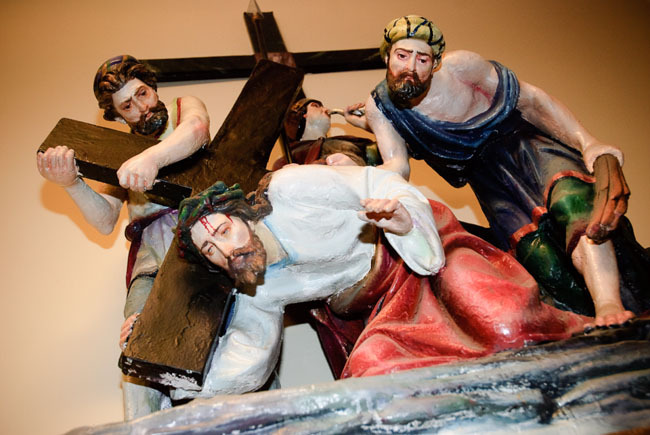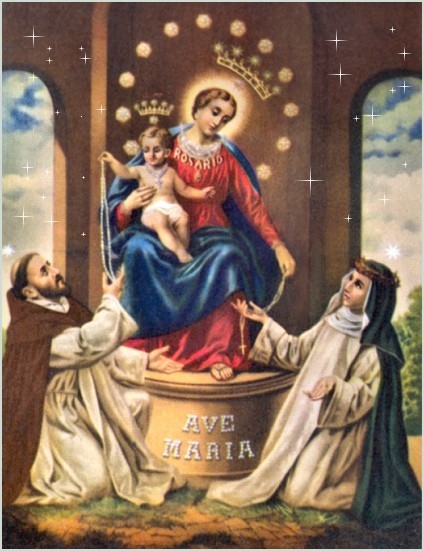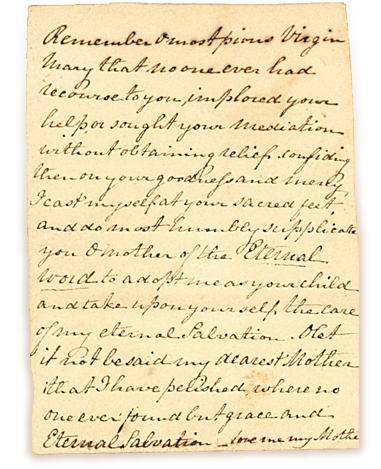|
March 30, 2012 07:05:28
Posted By DelvecchioRC
|
Once there was a beautiful garden. Of all the plants in the garden, the one that the master regarded as the most beautiful was a splendid and noble Bamboo. Year after year, Bamboo grew yet more beautiful and gracious. He was conscious of his master's love, yet he was modest and gentle in all things.
One day the master looked at Bamboo and said: "Bamboo, I want to use you." Bamboo flung his leafy head to the sky in utter delight. This was going to be the day in which he would find his completion and destiny! His voice came low: "Master, I am ready, use me as you want."
"Bamboo," the master’s voice said seriously, "I want to take you and cut you down."
A trembling of great horror shook Bamboo. "Cccut – me - down? Me whom you, master, have made the most beautiful in all your garden? Cut me down? Ah, not that, not that."
"Beloved Bamboo," the master’s voice grew even more serious. "If I don’t cut you down, I can’t use you."
The garden grew quiet. Then came a whisper. "Master, if you cannot use me unless you cut me down, then do it."
"Bamboo, beloved Bamboo, I also want to cut off your leaves."
"Master, master, spare me. Cut me down and lay me in the dust, but will you also take from me my leaves?"
"Bamboo alas! If I don’t cut them away, I can’t use you."
Bamboo shivered in terrible expectancy, whispering low. "Master, cut away." "Bamboo, Bamboo. I will also split you in two and cut out your heart, because unless I do this, I can’t use you."
"Master, master, then cut and divide."
So the master of the garden took Bamboo and cut him down and hacked off his leaves and divided him in two and cut out his heart. He carried him to where there was a spring of fresh, sparkling water in the midst of the master's dry fields. Then putting down one end of broken Bamboo into the spring he gently laid the other end into the water channel in his field.
The clear sparkling spring water raced joyously down the channel of Bamboo's torn body into the waiting fields. Then the rice was planted and the days went by. The shoots grew. The harvest came. In his brokenness Bamboo became a channel of abundant life to his master's world.
This is not just a story about Bamboo, but also of Christ. He emptied himself, taking the form of a slave, being born in human likeness. And being found in human form, he humbled himself and became obedient to the point of death – even death on a cross.
The prophet Isaiah talked about God’s servant who "had no dignity or beauty to make us take notice of him. There was nothing attractive about him, nothing that would draw us to him. We despised him and rejected him; he endured suffering and pain" (52:2,3).
Bamboo was stripped of all his beauty, split and laid down in the dirt so that he could serve his master. He served not just his master but also the plants in the field. He gave his life in order to give abundant life to the field. In a similar way, Christ was stripped and beaten, raised on a cross and died in agony, so that he could bring to us abundant life.
© Pastor Vince Gerhardy
|
|
April 14, 2011 09:13:25
Posted By DelvecchioRC
|

The Stations of the Cross originated in pilgrimages to Jerusalem. A desire to reproduce the holy places in other lands seems to have manifested itself at quite an early date. At the monastery of Santo Stefano at Bologna a group of connected chapels was constructed as early as the 5th century, by St. Petronius, Bishop of Bologna, which was intended to represent the more important shrines of Jerusalem, and in consequence, this monastery became familiarly known as "Hierusalem.” These may perhaps be regarded as the germ from which the Stations afterwards developed, though it is tolerably certain that nothing that we have before about the 15th century can strictly be called a Way of the Cross in the modern sense. Although several travelers who visited the Holy Land during the twelfth, thirteenth, and 14th centuries (e.g. Riccoldo da Monte di Croce, Burchard of Mount Sion, James of Verona), mention a "Via Sacra,” i.e., a settled route along which pilgrims were conducted, there is nothing in their accounts to identify this with the Way of the Cross, as we understand it. The devotion of the Via Dolorosa, for which there have been a number of variant routes in Jerusalem, was probably developed by the Franciscans after they were granted administration of the Christian holy places in Jerusalem in 1342. The earliest use of the word “stations,” as applied to the accustomed halting-places in the Via Sacra at Jerusalem, occurs in the narrative of an English pilgrim, William Wey, who visited the Holy Land in the mid-15th century, and described pilgrims following the footsteps of Christ to the cross. In 1521 a book called Geystlich Strass was printed with illustrations of the stations in the Holy Land. During the 15th and 16th centuries the Franciscans began to build a series of outdoor shrines in Europe to duplicate their counterparts in the Holy Land. The number of stations varied between eleven and thirty. In 1686, in answer to their petition, Pope Innocent XI granted to the Franciscans the right to erect stations within their churches. In 1731, Pope Clement XII extended to all churches the right to have the stations, provided that a Franciscan father erected them, with the consent of the local bishop. At the same time the number was fixed at fourteen. In 1857, the bishops of England were allowed to erect the stations by themselves, without the intervention of a Franciscan priest, and in 1862 this right was extended to bishops throughout the church.
In the Roman Catholic Church, Pope John Paul II led an annual public prayer of the Stations of the Cross at the Roman Colosseum on Good Friday. Originally, the Pope himself carried the cross from station to station, but in his last years when age and infirmity limited his strength, John Paul presided over the celebration from a stage on the Palatine Hill, while others carried the cross. Just days prior to his death in 2005, Pope John Paul II observed the Stations of the Cross from his private chapel. Each year a different person is invited to write the meditation texts for the Stations. Past composers of the Papal Stations include several non-Catholics. The Pope himself wrote the texts for the Great Jubilee in 2000 and used the traditional Stations.The celebration of the Stations of the Cross is especially common on the Fridays of Lent, especially Good Friday. Community celebrations are usually accompanied by various songs and prayers. Particularly common as musical accompaniment is the Stabat Mater. At the end of each station the Adoramus Te is sometimes sung. The Alleluia is also sung, except during Lent.
|
|
April 6, 2011 12:50:07
Posted By DelvecchioRC
|
Of all the methods of making the sign of the cross, making a little cross seems to be the most ancient. We have positive evidence in the early Fathers that such a practice was familiar to Christians in the second century. "In all our travels and movements", says Tertullian (De cor. Mil., iii), "in all our coming in and going out, in putting of our shoes, at the bath, at the table, in lighting our candles, in lying down, in sitting down, whatever employment occupieth us, we mark our foreheads with the sign of the cross". On the other hand this must soon have passed into a gesture of benediction, as many quotations from the Fathers in the fourth century would show. Thus St. Cyril of Jerusalem in his "Catecheses" (xiii, 36) remarks: "let us then not be ashamed to confess the Crucified. Be the cross our seal, made with boldness by our fingers on our brow and in every thing; over the bread we eat and the cups we drink, in our comings and in goings; before our sleep, when we lie down and when we awake; when we are travelling, and when we are at rest".
All this obviously leads up to the suggestion of a larger cross made over the whole body, and perhaps the earliest example which can be quoted comes to us from a source, possibly of the fourth or fifth century. In the life of St. Nino, a woman saint, honoured as the Apostle of Georgia, we are told in these terms of a miracle worked by her: "St. Nino began to pray and entreat God for a long time. Then she took her (wooden) cross and with it touched the Queen's head, her feet and her shoulders, making the sign of the cross and straightway she was cured" (Studia Biblica, V, 32).
On the whole it seems probable that the ultimate prevalence of the larger cross is due to an instruction of Leo IV in the middle of the ninth century. "Sign the chalice and the host", he wrote, "with a right cross and not with circles or with a varying of the fingers, but with two fingers stretched out and the thumb hidden within them, by which the Trinity is symbolized.
(Taken from the Catholic Encyclopedia)
|
|
March 30, 2011 06:20:27
Posted By DelvecchioRC
|
The traditional story of the rosary was that Mary herself appeared to Saint Dominic in the twelfth century. At that time, tradition says she gave him the rosary and promised Dominic that if he spread devotion to the rosary, his religious order would flourish. It is quite true that Dominic was quite devoted to the Blessed Mother, but no one knows for sure if Our Lady herself gave Dominic the rosary. If she did, it is quite certain that she did not give him a rosary that looks like the one we have today.
Originally the rosary had 150 beads, the same number of psalms in the Bible. In the twelfth century, religious orders recited together the 150 Psalms as a way to mark the hours of the day and the days of the week. Those people who didn’t know how to read wanted to share in this practice, so praying on a string of 150 beads or knots began as a parallel to praying the psalms. It was a way that the illiterate could remember the Lord and his mother throughout the day. The “Divine Office”; the official prayer of the church; is the recitation of the psalms over a four week period, and is still prayed today.
This first rosary was prayed as we do today, a person would pass their fingers over each bead and say a prayer, usually the “Our Father”. The “Hail Mary” as we know it wasn’t even around at that time.
The Hail Mary owes its origin to the rosary. When people said the rosary in the twelfth century, Gabrielle’s greeting “Hail Mary, full or grace, the Lord is with thee” was often said along with the Our Father. Later, Elizabeth’s greeting ”blessed are you among women” was added. It was not until the sixteenth century that the words “Holy Mary., Mother of God, pray for us sinners now and at the hour of our death” were added.
Various people have added other things to the rosary over the centuries. In the fifteenth century, a Carthusian monk divided the rosary into fifteen brackets (or decades) and a Dominican assigned mysteries to each of the decades. These mysteries were events in the life of Jesus as written in the gospels. By meditating on these events even the illiterate could know the stories in the Bible. These decades were the same as ours except for the last two Glorious mysteries. In those two, the Coronation and the Assumption together made up the fourteenth decade and the fifteenth decade was the Last Judgment.
On October 16, 2002, Pope John Paul II, declared that the following year would be the “Year of the Rosary”. For the first time in centuries a change was made in the rosary. The Pope added and defined 5 new mysteries that concerned events in the public life of Jesus. These new mysteries were called the “Luminous Mysteries” or “Mysteries of Light”
Today’s complete rosary is now made up of twenty decades of the Hail Mary, separated by an Our Father and a Glory Be and sometimes the Fatima prayer. Evidence again that the rosary is a living prayer that grows with the church. We usually break the rosary into four sets. The four sets are The Joyful Mysteries, The Sorrowful Mysteries, The Glorious Mysteries, and the Luminous Mysteries. One set is prayed on a rosary that has five decades. Each set is prayed on designated days of the week. There are variations however, and in some countries the rosary may even have different mysteries.
Despite all the additions and changes, the important core of the rosary has always remained the same. It is a way for God’s people to make holy the day, and to remember the life of Jesus and his mother.

|
|
March 16, 2011 07:25:31
Posted By DelvecchioRC
|
Below is a copy of the Memorare written by St. Elizabeth Ann Seton between 1804-1820.

Memorare, from Latin "Remember", is frequently misattributed to the 12th century Cistercian monk Saint Bernard of Clairvaux, apparently due to confusion with its 17th century popularizer, Father Claude Bernard, who stated that he learned it from his own father. Trusting his charges to the care and intercession of the Blessed Virgin Mary, Fr. Bernard employed the Memorare extensively in his work of evangelization to great effect. At one time he had more than 200,000 leaflets printed with the Memorare in various languages dso he could distribute the leaflets wherever he felt they would do some good.
However, we know that the Bernard family did not create the prayer since years earlier the prayer is documented as being used by St. Francis de Sales. The de Sales family were members of the minor nobility and staunch Catholics, but St. Francis de Sales fell victim to the religious turmoil of his age which tormented his soul. The torment of despair came to a sudden end as he knelt in prayer before the statue of Our Lady of Good Deliverance at the Church of St. Etienne des Gres in Paris, saying the Memorare. Francis credited the Blessed Virgin with saving his from falling into despair or heresy; he recited the Memorare day after day, and she did not leave him unaided.
It is believed that teh Memorare first appeared as part of a longer 15th century prayer, "Ad sanctitatis tuae pedes, dulcissima Virgo Maria." Ad sanctitatis tuae pedes, dulcissima Virgo Maria is a rather long prayer that appears in a number of printed books and manuscripts from the last quarter of the 15th century and onwards. It appears in such works as the Hortulus Animae (15th cent.), the Antidotarius Animae (a5th cent.) of Nicholas de Saliceto (Cistercian abbot of Bomgart, near Strasbourg), and the Precationum piarum Enchiridion, compiled around 1570 by Simon Verepaeus. The Memorare is an integral part of the text in each case. Exactly when the Memorare was extracted from this longer prayer has not yet been determined, but it likely occurred in the later part of the 16th century, around the time of Fr. Bernard and his father.
Since the later part of the 16th century several variants of the Memorare have appeared. The exact wording of the prayer stabilized during the 19th century, to that which we recite at the end of Mass in the parish, and was first indulgenced by Pope Pius IX in 1846. The church continues to grant a partial indulgence to the faithful who recite the Memorare.
Sacred Hearts-St. Stephen parish's devotion to the blessed mother has been long standing, however it has been under the pastorship of Fr. Anthony J. Sansone that the Memorare prayer has become our parish prayer of devotion to the blessed mother.
|
|
|
|

